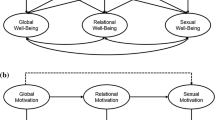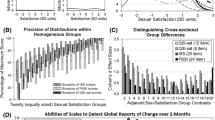Abstract
Past research suggests that sexual satisfaction may be partially dependent on sexual motives (the reasons people have sex). The primary goal of this study was to determine which of a wide range of empirically derived sexual motives were related to sexual satisfaction, and whether gender differences existed in these relationships. Examining data from 544 undergraduate participants (93 men, 451 women), we found that certain types of motives predicted levels of sexual satisfaction for both genders. However, a greater number of motive categories were related to satisfaction for women than for men, and sexual motives were a more consistent predictor of satisfaction in general for women than for men. We also found that empirical categories of motives predicted more variance in satisfaction ratings than did previously used theoretical categories. These findings suggest that a wide range of sexual motives are related to sexual satisfaction, that these connections may be moderated by gender, and that empirically-constructed categories of motives may be the most effective tool for studying this link.
Similar content being viewed by others
Notes
Data from 214 participants were excluded due to missing gender information (n = 5) or participant report of no current relationship (n = 209).
To address the issue of administering the FSFI to sexually inactive participants (Meyer-Bahlburg & Dolezal, 2007), we conducted an additional set of analyses comparing the results of currently active to inactive individuals and found no differences in direction or significance level of the findings. Thus, all reported findings reflect the full set of participants.
References
Ahrold, T., Stephenson, K., & Meston, C. M. (in press). Validated questionnaires in female sexual function assessment. In J. Mulhall, I. Goldstein, L. Incrocci, & R. Rosen (Eds.), Cancer & sexuality. New York: Springer.
Apt, C., Hurlbert, D., Pierce, A., & White, C. (1996). Relationship satisfaction, sexual characteristics and the psychosocial well-being of women. Canadian Journal of Human Sexuality, 5, 195–210.
Barrientos, J., & Páez, D. (2006). Psychosocial variables of sexual satisfaction in Chile. Journal of Sex and Marital Therapy, 32, 351–368.
Baumeister, R., & Vohs, K. (2004). Sexual economics: Sex as female resource for social exchange in heterosexual interactions. Personality and Social Psychology Review, 8, 339–363.
Browning, J., Hatfield, E., Kessler, D., & Levine, T. (2000). Sexual motives, gender, and sexual behavior. Archives of Sexual Behavior, 29, 135–153.
Byers, E. (2005). Relationship satisfaction and sexual satisfaction: A longitudinal study of individuals in long-term relationships. Journal of Sex Research, 42, 113–118.
Colson, M., Lemaire, A., Pinton, P., Hamidi, K., & Klein, P. (2006). Sexual behaviors and mental perception, satisfaction and expectations of sex life in men and women in France. Journal of Sexual Medicine, 3, 121–131.
Cooper, M., Shapiro, C., & Powers, A. (1998). Motivations for sex and risky sexual behavior among adolescents and young adults: A functional perspective. Journal of Personality and Social Psychology, 75, 1528–1558.
Costa, J., Fagan, P., Peidmont, R., Ponticas, Y., & Wise, T. (1992). The five-factor model of personality and sexual functioning in outpatient men and women. Psychiatric Medicine, 10, 199–215.
Davison, S. L., Bell, R. J., LaChina, M., Holden, S. M., & Davis, S. R. (2009). The relationship between self-reported sexual satisfaction and general well-being in women. Journal of Sexual Medicine, 6, 2690–2697.
Derogatis, L., & Melisaratos, N. (1979). The DSFI: A multidimensional measure of sexual functioning. Journal of Sex and Marital Therapy, 5, 244–281.
Dunn, K., Croft, P., & Hackett, G. (2000). Satisfaction in the sex life of a general population sample. Journal of Sex and Marital Therapy, 26, 141–151.
Edwards, J., & Booth, A. (1994). Sexuality, marriage, and well-being: The middle years. In A. S. Rossi (Ed.), Sexuality across the life course (pp. 233–259). Chicago: University of Chicago Press.
Ferenidou, F., Kapoteli, V., Moisidis, K., Koutsogiannis, I., Giakoumelous, A., & Hatzichristou, D. (2008). Presence of a sexual problem may not affect women’s satisfaction from their sexual function. Journal of Sexual Medicine, 5, 631–639.
Gottman, J., & Gottman, J. (2008). Gottman method couple therapy. In A. Gurman (Ed.), Clinical handbook of couple therapy (pp. 138–164). New York: Guilford Press.
Greenberg, L., & Johnson, S. (1988). Emotionally focused therapy for couples. New York: Guilford Press.
Grossbard, J., Lee, C., Neighbors, C., Hendershot, C., & Larimer, M. (2007). Alcohol and risky sex in athletes and nonathletes: What roles do sex motives play? Journal of Studies on Alcohol and Drugs, 68, 566–574.
Haavio-Mannila, E., & Kontula, O. (1997). Correlates of increased sexual satisfaction. Archives of Sexual Behavior, 26, 399–419.
Hally, C., & Pollack, R. (1993). The effects of self-esteem, variety of sexual experience, and erotophilia on sexual satisfaction in sexually active heterosexuals. Journal of Sex Education and Therapy, 19, 183–192.
Hayes, R., Dennerstein, L., Bennet, C., Sidat, M., Gurrin, L., & Fairley, C. (2008). Risk factors for female sexual dysfunction in the general population: Exploring factors associated with low sexual function and sexual distress. Journal of Sexual Medicine, 5, 1681–1693.
Heaven, P., Fitzpatrick, J., Craig, F., Kelly, P., & Sebar, G. (2000). Five personality factors and sex: Preliminary findings. Personality and Individual Differences, 28, 1133–1141.
Hill, C., & Preston, L. (1996). Individual differences in the experience of sexual motivation: Theory and measurement of dispositional sexual motives. Journal of Sex Research, 33, 27–45.
Hurlbert, D., Apt, C., & Rabehl, S. (1993). Key variables to understanding female sexual satisfaction: An examination of women in nondistressed marriages. Journal of Sex and Marital Therapy, 19, 154–165.
Impett, E., Peplau, L., & Gable, S. (2005). Approach and avoidance sexual motives: Implications for personal and interpersonal well-being. Personal Relationships, 12, 465–482.
Impett, E., Strachman, A., Finkle, E., & Gable, S. (2008). Maintaining sexual desire in intimate relationships: The importance of approach goals. Journal of Personality and Social Psychology, 94, 808–823.
Impett, E., & Tolman, D. (2006). Late adolescent girls’ sexual experiences and sexual satisfaction. Journal of Adolescent Research, 21, 628–646.
Judge, T., Erez, A., Bono, J., & Thoresen, C. (2002). Are measures of self-esteem, neuroticism, locus of control, and generalized self-efficacy indicators of a common core construct? Journal of Personality and Social Psychology, 83, 693–710.
Kelly, E., & Conley, J. (1987). Personality and compatibility: A prospective analysis of marital stability and marital satisfaction. Journal of Personality and Social Psychology, 52, 27–40.
King, M., Holt, V., & Nazareth, I. (2007). Women’s views of their sexual difficulties: Agreement and disagreement with clinical diagnoses. Archives of Sexual Behavior, 36, 281–288.
Lam, D., Donaldson, C., Brown, Y., & Malliaris, Y. (2005). Burden and marital and sexual satisfaction in the partners of bipolar patients. Bipolar Disorders, 7, 431–440.
Larson, J., Anderson, S., Holman, T., & Niemann, B. (1998). A longitudinal study of the effects of premarital communication, relationship stability, and self-esteem on sexual satisfaction in the first year of marriage. Journal of Sex and Marital Therapy, 24, 193–206.
Laumann, E., Palik, A., & Rosen, R. (1999). Sexual dysfunction in the United States: Prevalence and predictors. Journal of the American Medical Association, 281, 537–544.
MacNeil, S., & Byers, E. (1997). The relationships between sexual problems, communication, and sexual satisfaction. Canadian Journal of Human Sexuality, 6, 277–283.
Masters, W., & Johnson, V. (1966). Human sexual response. Boston, MA: Little & Brown.
Meston, C. M. (2003). Validation of the Female Sexual Function Index (FSFI) in women with female orgasmic disorder and in women with hypoactive sexual desire disorder. Journal of Sex and Marital Therapy, 29, 39–46.
Meston, C. M., & Buss, D. (2007). Why humans have sex. Archives of Sexual Behavior, 36, 477–507.
Meston, C. M., & Trapnell, P. (2005). Development and validation of a five-factor Sexual Satisfaction and Distress Scale for Women: The Sexual Satisfaction Scale for Women (SSS-W). Journal of Sexual Medicine, 2, 66–81.
Meyer-Bahlburg, H., & Dolezal, C. (2007). The Female Sexual Function Index: A methodological critique and suggestions for improvement. Journal of Sex and Marital Therapy, 33, 217–224.
Minnen, A., & Kampman, M. (2000). The interaction between anxiety and sexual functioning: A controlled study of sexual functioning in women with anxiety disorders. Sexual and Relationship Therapy, 15, 47–57.
Morokoff, P., & Gillilland, R. (1993). Stress, sexual functioning, and marital satisfaction. Journal of Sex Research, 30, 43–53.
Nelson, P. A. (1978). Personality, sexual functions, and sexual behavior: An experiment in methodology. Unpublished doctoral dissertation, University of Florida.
Nystrom, S., & Lindegard, B. (1975). Depression: Predisposing factors. Acta Psychiatrica Scandinavica, 51, 77–87.
Perrone, K. M., & Worthington, E. L. (2001). Factors influencing ratings of martial quality by individuals within dual-career marriages: A conceptual model. Journal of Counseling Psychology, 48, 3–9.
Peter, K., & Horn, L. (2005). Gender differences in participation and completion of undergraduate education and how they have changed over time. Washington, DC: U.S. Department of Education, National Center for Education Statistics (NCES 2005–169).
Regan, P., & Dreyer, C. (1999). Lust? Love? Status? Young adults’ motives for engaging in casual sex. Journal of Psychology and Human Sexuality, 11, 1–24.
Rosen, R., Brown, C., Leiblum, S., Meston, C. M., & Shabsigh, R. (2000). The Female Sexual Function Index (FSFI): A multidimensional self-report instrument for the assessment of female sexual function. Journal of Sex and Marital Therapy, 26, 191–208.
Schiavi, R. C., & Mandeli, J. S. (1994). Sexual satisfaction in healthy aging men. Journal of Sex and Marital Therapy, 20, 3–13.
Schwartz, N. (1999). Self reports: How the questions shape the answers. American Psychologist, 54, 93–105.
Singer, B., & Toates, F. (1987). Sexual motivation. Journal of Sex Research, 23, 481–501.
Socher, S. (1999). Correlates of sexual satisfaction in women. Dissertation Abstracts International Section A: Humanities and Social Sciences, 60, 250.
Song, J., Bergen, M., & Schumm, W. (1995). Sexual satisfaction among Korean–American couples in the midwestern United States. Journal of Sex and Marital Therapy, 21, 147–158.
Sprecher, S. (2002). Sexual satisfaction in premarital relationships: Associations with satisfaction, love, commitment, and stability. Journal of Sex Research, 39, 190–196.
Steele, J., James, J., & Barnett, R. (2002). Learning in a man’s world: Examining the perceptions of undergraduate women in male-dominated academic areas. Psychology of Women Quarterly, 26, 46–50.
Toates, F. (2009). An integrative theoretical framework for understanding sexual motivation, arousal, and behavior. Journal of Sex Research, 46, 168–193.
Ventegodt, S. (1998). Sex and the quality of life in Denmark. Archives of Sexual Behavior, 27, 295–307.
Waite, L. J., & Joyner, K. (2001). Emotional satisfaction and physical pleasure in sexual unions: Time horizon, sexual behavior, and sexual exclusivity. Journal of Marriage & the Family, 63, 247–264.
White, L., & Keith, B. (1990). The effect of shift work on the quality and stability of marital relations. Journal of Marriage & the Family, 52, 453–462.
Winifred, A., Kuyper, L., & Greunsven, G. (2003). Need for intimacy in relationships and motives for sex as determinants of adolescent condom use. Journal of Adolescent Health, 33, 154–164.
Zajecka, J., Dunner, D. L., Gelenberg, A. J., Hirschfeld, R. M., Kornstein, S. G., Ninan, P. T., et al. (2002). Sexual function and satisfaction in the treatment of chronic major depression with nefazodone, psychotherapy, and their combination. Journal of Clinical Psychiatry, 63, 709–716.
Acknowledgments
This research was supported, in part, by Grant Number R01 HD51676-3 from the National Institute for Child Health and Human Development to Cindy Meston. Its contents are solely the responsibility of the authors and do not necessarily represent the official views of the National Institute for Child Health and Human Development.
Author information
Authors and Affiliations
Corresponding author
Rights and permissions
About this article
Cite this article
Stephenson, K.R., Ahrold, T.K. & Meston, C.M. The Association Between Sexual Motives and Sexual Satisfaction: Gender Differences and Categorical Comparisons. Arch Sex Behav 40, 607–618 (2011). https://doi.org/10.1007/s10508-010-9674-4
Received:
Revised:
Accepted:
Published:
Issue Date:
DOI: https://doi.org/10.1007/s10508-010-9674-4




